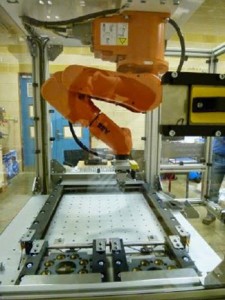Unlocking the potential of robotic automation
 Mike Wilson, general industry sales and marketing manager at ABB Robotics UK and Ireland, comments on how starting small could be the key to unlocking the potential of robotic automation in the UK.
Mike Wilson, general industry sales and marketing manager at ABB Robotics UK and Ireland, comments on how starting small could be the key to unlocking the potential of robotic automation in the UK.
As someone with over 30 years of experience in robotics, it’s a source of great personal frustration for me to see the UK languishing in the lower regions of the list of developed countries using robotic automation. With only 28 robots per 10,000 non-automotive employees, the UK trails in 21st place in the world. Based on my own experience, I can think of hundreds of potential applications that could benefit from using robots, particularly in the SME sector.
Even with the availability of real proof showing how robots can help transform productivity and competitiveness, turning interest into action, particularly amongst smaller companies, continues to be hampered by concerns over cost, lack of knowledge, and flexibility.
Yet it doesn’t have to be this way. When it comes to robot-based automation, starting small and simple can bring tangible benefits, whilst allowing production teams and management to get used to this new technology.
There is now a growing raft of packaged robotic systems available that offer great opportunities for smaller companies in particular to take their first steps into the world of robotic automation. Pitched at a readily affordable price and offering simple set up and programming, these systems offer an attractive opportunity for anyone keen on introducing robotic automation into their operation.
Small-scale cellular systems
Our own robots are increasingly featuring in small-scale cellular systems that give users a simple yet effective way of automating a wide variety of processes, from picking and packing through to machine tool loading and unloading.
Our system integrator, CKF Systems, for example, has developed a low cost robotic packing system enabling users in the food and beverage industry to enjoy improved throughput and consistency and reduced wastage, without the perceived cost or complexity associated with robotic automation. Simple to operate and maintain, the system doesn’t need highly-skilled operators, helping to overcome concerns over training and experience.
Easy programming allows it to be readily adapted to handle a range of medium to high-speed repetitive tasks.
Another example is the RobotCube cell developed by Notio. Featuring a simple design based on customisable modules, the RobotCube has been designed to offer an entry-level standard robot cell. Its compact footprint and easy configuration and reconfiguration means it can be readily adapted to handle a wide variety of parts handling applications.
The RobotCube is based on a cell developed by Notio for global contact lens manufacturer CooperVision’s R&D facility in Southampton, which develops production processes for introduction in serial manufacture in the company’s plants worldwide.
The cell was developed to automate the process of transferring contact lenses between the moulding and curing stages, with the aim of saving time and freeing up staff for other duties.
The robot is used to transfer parts from the injection moulding process that arrive in batches of eight, to a tray with over two hundred parts, which are placed and orientated to a specific pattern ready to go into the cure process. By enabling the faster transfer of contact lenses between the moulding and curing processes, it provides a reduced cycle time of 30 percent.
The cell uses an ABB IRB 120 industrial robot that weighs just 25kg and can handle a payload of 3kg. The robot was selected for its small size and its ability to meet the application requirement of handling eight parts in ten seconds. As a way of making the cell even more cost-effective, the robot’s built-in controller is used to manage the whole cell, eliminating the requirement for a PLC as well as an HMI.
Benefits for machine shops
The small cell approach offers particular benefits for the UK’s machine shops. A new cell, developed by Swedish automation specialist SVIA, is now available which can be used to simultaneously handle multiple parts from up to three machines at a time. Built around an ABB robot, and SVIA’s vision system and parts identification software, the cell is ideal for loading and unloading a wide variety of different parts.
The cell is simple to master, with just two days typically needed for installation and commissioning. The time needed to teach new parts is reduced to just 15 minutes by a step-by-step process, which can be simply carried out by the machine operator. By enabling the system to be readily switched between different parts, the cell offers excellent flexibility across batch runs from hundreds down to just 50 parts.
It’s totally understandable that the first step in any journey is always going to be the hardest one to make. However, when it comes to making a switch to robotic automation, help and advice are available at every stage. ABB and its system integrator network, for example, can offer expert advice across a range of industrial applications, as well as training to help you fill any knowledge gaps and ensure that you get the most out of an investment in robotic technology.
Visit the ABB Robotics website for more information.
See all stories for ABB Robotics















